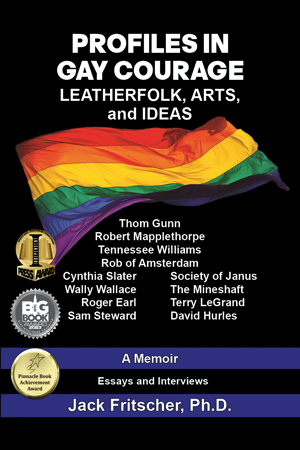NON-FICTION BOOK
by Jack Fritscher
How to Quote from this Material
Copyright Jack Fritscher, Ph.D. & Mark Hemry - ALL RIGHTS RESERVED
PROFILES IN GAY COURAGE
Leatherfolk, Arts, and Ideas
Volume 1
by Jack Fritscher, PhD

Also available in PDF and Flipbook
EDWARD PARENTE
1941-1992
Wakefield Poole’s Boys in the Sand and the NYT
Raised in Queens, Long Island, Ed Parente (March 11, 1941-November 19, 1992) was a fine artist and sculptor who attended Parsons School of Design. He created the signature poster and graphics for his longtime friend Wakefield Poole’s ground-breaking Boys in the Sand (1971). Known for his pointillist technique, his stylish line drawing for the film was the first gay display ad to be published in the New York Times. They met on Fire Island and became, Wake said, “instant friends.”
In 1969, he starred in Poole’s ten-minute film The Gift at the same moment his first solo show opened at Cannabis Gallery, 295 Mercer Street, New York. In 1971, the Earth Gallery, now evaporated from Manhattan, was selling his psychedelic lithographs of astrological signs to “delight the 70s acid-tripper in you.” One of those cards — the moustached gladiator standing on a beach — became the ad for Boys in the Sand. He also sold his work, including his “pre-futuristic primitive” disco feather masks, and sculptures of found animal skulls adorned with leather and feathers, at Ballardos Glassware shop on Christopher Street.
Famous on the sands of Fire Island Pines in the 1960s for netting butterflies for his delicate boxed sculptures, he shaped his twin sister’s face into his plaster-cast work. To this day I own and love several of his sculptures. One is a bouquet of eighteen white-plaster male fingertips, each standing two or three knuckles tall, with a single yellow butterfly specimen perched on the tallest finger. The other is a white-plaster mask of his sister’s face wrapped in white silk and creamy lace which Ed found blowing down Castro Street. I named the sculpture “The Dead Bride” as a kind of empathetic homage in honor of all the women whom gay men loved but could not marry. Both are encased in Parente’s signature Plexiglas boxes.
As a graphic artist supporting Poole’s San Francisco career, he moved to the City in 1975 where as a smoldering five-foot-six Italian sensualist, he was a gloriously stoned habitue of the Barracks bath where for two years without speaking we fucked like destiny every time we saw each other. Then, one night after those years of hot scenes, we were kicked back sharing a joint on the stairs, and spoke for the first time.
“Hi, I’m Ed Parente.”
“Hi, I’m Jack Fritscher.”
“All my friends have been telling me I should meet you.”
“All my friends have told me I should meet you.”
We laughed and bonded instantly as friends and never fucked together again.
And then we found that for years we had lived around the corner from each other in upper Noe Valley. I lived at 4436 25th Street where I edited Drummer magazine and he lived at 403 Hoffman Street which doubled as his working studio and open gallery. So began our at-home social visits. That was the way glorious anonymous sex worked — until it became personal friendship that was just too incestuous in our hot little crowd.
My longtime friend from 1973 and housemate on 25th Street, the Drummer photographer Jim Stewart, the late author of the gorgeously nostalgic memoir Folsom Street Blues, wrote in his gay history column in the Bay Area Reporter, May 14, 2014: “You never know what, or who, you might find at a flea market [in Alameda on May 14, 1977]. We found Michael Monroe and Ed Parente. Ed was gathering vintage doll parts for his sculptures. He’d pull off the heads, sometimes the limbs, put them in his rucksack, then toss the remains in a handy trash can. He paired his flea market trophies together with butterfly wings and nature’s random ephemera in Lucite boxes that were featured at high-end galleries in the tonier parts of the City.”
In the 1970s, Ed exhibited at San Francisco’s first new gay art galleries: Oscar Streaker Robert Opel’s Fey-Way Studio in SOMA; Erotic Hands pornstar Richard Trask’s atelier, The Wizard’s Emerald City, on Market Street; and Wakefield Poole’s Hot Flash of America on Market at Castro which hosted the first exhibition of his disco masks behind Plexiglass titled “Boxes.” In the 1980s, he also exhibited his masks and faces and totems and fingers to crowds at the Church Street Fair, the Castro Street Fair, and the Folsom Street Fair. In summer 1984, when the first gay-owned financial institution, Atlas Savings and Loan, opened its 18th Street branch in the Castro, 4128 18th Street, it courted customers by exhibiting his work.
He designed the Pegasus-motif invitations, posters, and pop-art tin-can gift sculptures for Michael Maletta’s Creative Power Foundation’s legendary “Night Flight,” San Francisco’s first mega-party which he co-produced as New Year’s Eve 1977 welcomed 1978. To market his art, he and Tom Sandburg founded the greeting card company Cold Shower Press.
His much published work appeared in Drummer magazine. He is referenced in Wakefield Poole’s autobiography Dirty Poole: A Sensual Memoir (2011), in Jim Tushinski’s documentary Dirty Poole (2011), and in the history book Gay San Francisco: Eyewitness Drummer (2008).